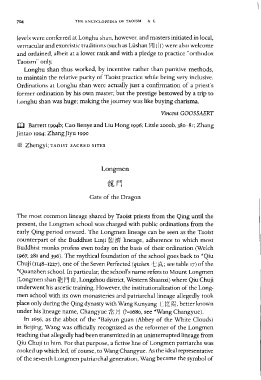Page 746 - The Encyclopedia of Taoism v1_A-L
P. 746
704 THE ENCYCLOPEDIA OF TAOISM A-L
levels were conferred at Longhu shan, however, and masters initiated in local,
vernacular and exorcistic tradi tions (such as Lilshan r,r\lll,) were also welcome
and ordained, albeit at a lower rank and with a pledge to practice "orthodox
Taoism" only.
Longhu shan thus worked, by incentive rather than punitive methods,
to maintain the relative purity of Taoist practice while being very inclusive.
Ordinations at Longhu shan were actually just a confirmation of a priest's
former ordination by his own master, but the prestige bestowed by a trip to
Longhu shan was huge; making the journey was like buying charisma.
Vincent GOOSSAERT
W Barrett 1994b; Cao Benye and Liu Hong 1996; Little 2ooob, 380-81; Zhang
Jintao 1994; ZhangJiyu 1990
* Zhengyi; TAOIST SACRED SITES
Longmen
Gate of the Dragon
The most common lineage shared by Taoist priests from the Qing until the
present, the Longmen school was charged with public ordinations from the
early Qing period onward. The Longmen lineage can be seen as the Taoist
counterpart of the Buddhist Linji l~al; ffif lineage, adherence to which most
Buddhist monks profess even today on the basis of their ordination (Welch
1967, 281 and 396). The mythical foundation of the school goes back to *Qiu
Chuji (II48-1227), one of the Seven Perfected (qizhen {: J');; see table 17) of the
*Quanzhen school. In particular, the school's name refers to Mount Longmen
(Longmen shan ~~ r, UJ , Longzhou district, Western Shaanxi) where Qiu Chuji
underwent his ascetic training. However, the institutionalization of the Long-
men school with its own monasteries and patriarchal lineage allegedly took
place only during the Qing dynasty with Wang Kunyang E tl! 1;1i , better known
under his lineage name, Changyue 1l\')'j (?-1680, see *Wang Changyue).
In r656, as the abbot of the *Baiyun guan (Abbey of the White Clouds)
in Beijing, Wang was officially recognized as the reformer of the Longmen
teaching that allegedly had been transmitted in an uninterrupted lineage from
Qiu Chuji to him. For that purpose, a fictive line of Longmen patriarchs was
cooked up which led, of course, to Wang Changyue. As the ideal representative
of the seventh Longmen patriarchal generation, Wang became the symbol of

